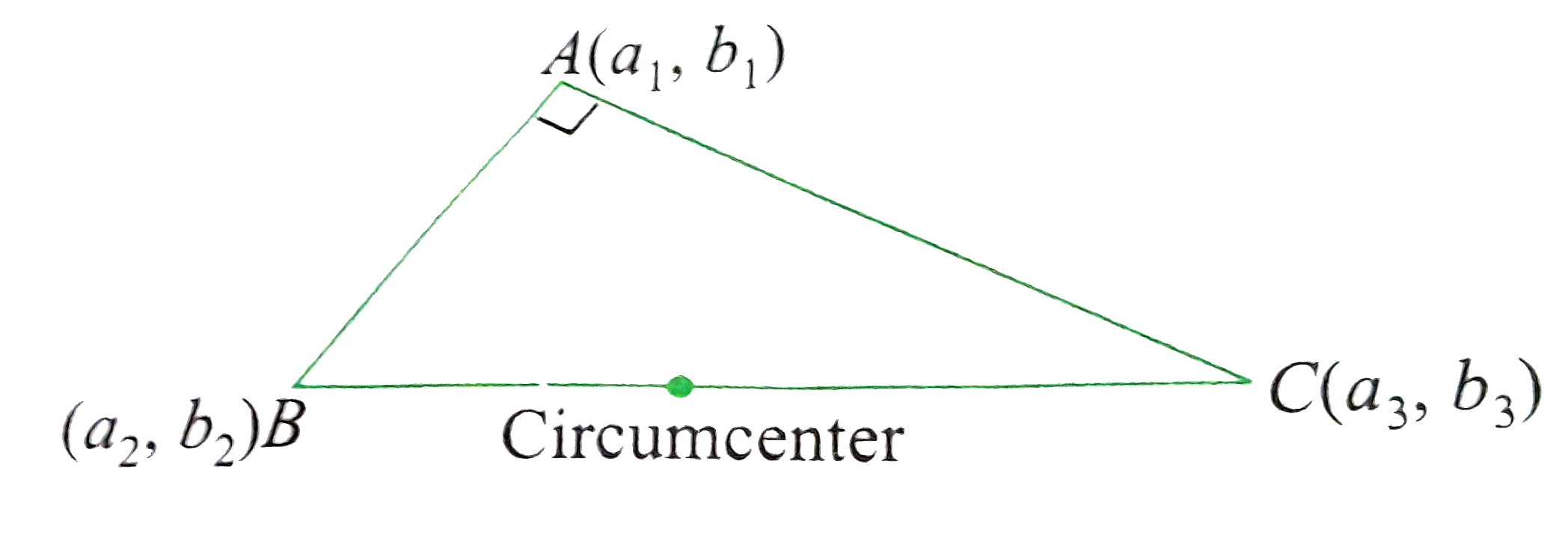If (b2−b1)(b3−b1)+(a2−a1)(a3−a1)=0, then prove that the circumcenter of the triangle having vertices (a1,b1),(a2,b2) and (a3,b3) is (a2+a32,b2+b32).
Given (b2−b1)(b3−b1)+(a2−a1)(a3−a1)=0

or (b2−b1)(b3−b1)=−(a2−a1)(a3−a1)
or (b2−b1a2−a1)(b3−b1a3−a1)=−1
or (slope of AB)×(slope of AC)=−1
Therefore, the triangle is right -angled at point (a1,b2). Hence, the circumcenter is the midpoint of (a2b2) and (a3,b3) which is (a2+a32,b2+b32)
Topper's Solved these Questions
- COORDINATE SYSYEM BOOK - CENGAGE ENGLISHCHAPTER - COORDINATE SYSYEM EXERCISE - Illustration1.48
1 Videos
- COORDINATE SYSYEM BOOK - CENGAGE ENGLISHCHAPTER - COORDINATE SYSYEM EXERCISE - Illustration1.49
1 Videos
- COORDINATE SYSYEM BOOK - CENGAGE ENGLISHCHAPTER - COORDINATE SYSYEM EXERCISE - Illustration1.46
1 Videos
- COORDINATE SYSTEMBOOK - CENGAGE ENGLISHCHAPTER - COORDINATE SYSTEMEXERCISE - Multiple Correct Answers Type
2 Videos
- CROSS PRODUCTS BOOK - CENGAGE ENGLISHCHAPTER - CROSS PRODUCTS EXERCISE - DPP 2.2
13 Videos
Similar Questions
If ∣∣ ∣ ∣∣x1y11x2y21x3y31∣∣ ∣ ∣∣=∣∣ ∣∣a1b11a2b21a3b31∣∣ ∣∣
then the two triangles with vertices (x1,y1),(x2,y2),(x3,y3) and (a1,b1),(a2,b2),(a3,b3) are
View SolutionIf |x1y11x2y21x3y31|=|a1b11a2b21a3b31| then the two triangles with vertices (x1,y1),(x2,y2),(x3,y3) and (a1,b1),(a2,b2),(a3,b3) are equal to area (b) similar congruent (d) none of these
View SolutionIf the points (a1,b1), (a2,b2) and (a1+a2, b1+b2) are collinear, show that a1b2=a2b1 .
View SolutionIf the lines a1x+b1y+1=0, a2x+b2y+1=0 and a3x+b3y+1=0 are concurrent, show that the points (a1,b1), (a2,b2)and (a3,b3) are collinear.
View SolutionIf the lines a1x+b1y+1=0, a2x+b2y+1=0 and a3x+b3y+1=0 are concurrent, show that the points (a1,b1), (a2,b2)and (a3,b3) are collinear.
View SolutionIf the equation of the locus of a point equidistant from the points (a1,b1) and (a2,b2) is (a1−a2)x+(b2+b2)y+c=0, then the value of C is
View SolutionProve that the value of each the following determinants is zero: ∣∣ ∣∣a1la1+mb1b1a2la2+mb2b2a3la3+mb3b3∣∣ ∣∣
View SolutionThe equation Ax−a1+A2x−a2+A3x−a3=0,whereA1,A2,A3>0anda1<a2<a3 has two real roots lying in the invervals.
(A) (a1,a2)and(a2,a3) (B) (−∞,a1)and(a3,∞) (C) (A1,A3)and(A2,A3) (D) none of these
View SolutionIf a2a3a1a4=a2+a3a1+a4=3(a2−a3a1−a4) then a1,a2,a3,a4 are in :
View SolutionIf a1,a2,a3,a4 be the coefficient of four consecutive terms in the expansion of (1+x)n, then prove that: a1a1+a2+a3a3+a4=2a2a2+a3.
View Solution
